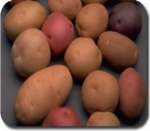
A variety can be defined as an assemblage of cultivated plants that have clearly distinguishable characteristics and that retain these characteristics when reproduced. In North America the term variety is synonymous with cultivar.
New potato varieties are produced each year by potato breeders in Canada and the United States as well as other countries of the world. In Canada the national potato breeding program is located at the Agriculture Canada Research Station, Fredericton and the Potato Breeding Substation located at Benton Ridge.
To develop a new variety, scientists first select parents that are predicted to yield progeny with the desired characteristics. Crosses are made between selected parents by obtaining pollen from the stamens of the male parent to fertilize the ovules of the female parent. The ovules develop into true seeds. The seeds are collected, dried and planted in greenhouses. The tiny tubers produced from the greenhouse-grown seedlings are field planted the following year in plots containing a single hill. At harvest 10-15 percent are selected for further evaluation.
Seedlings retained from the single-hill plantings are grown the subsequent year in plots containing four hills and those surviving this evaluation are planted the following year in plots containing 16 hills. The seedlings that have survived the first three years of evaluation are grown in 100 hill plots during the fourth year.
For the next several years the outstanding selections are grown in regional adaptation trials, block trials and finally in grower trials. Projects to determine consumer acceptance as well as pilot runs in processing plants are an integral part of the evaluation.
Selections with outstanding performance are proposed to the seed division of Agriculture Canada for registration and release to the commercial potato industry.
Selecting a Potato Variety
There are many varieties of potatoes to choose from for commercial or home garden production. Varieties should be chosen in regard to adaptation to the area, disease resistance and end-use characteristics for available markets.
When growing a new variety, only a small acreage should be grown to determine if that variety is suited to the soil type and microclimate of the farm. This is especially critical if the variety being produced has been bred in some other area.
Many varieties have varying degrees of resistance to a number of diseases. Varieties with specific resistances should be selected where a disease problem is known to recur.
Before selecting a variety for commercial production a market should be developed for that variety. Some varieties are suitable for several uses, however, most have been developed for one or two specific uses. There are four main general use classifications of the potato in Atlantic Canada. These include processing into french fries, processing into potato chips, table or fresh market which includes boiling and baking, and export seed. It is important to know the desired requirements for each use and to choose varieties that have the characteristics to meet these requirements.
Use Requirements
Processing into French Fries
- Long shaped tubers. Long tubers are required to produce long french fries.
- High dry matter or high specific gravity. High dry matter is essential as the water in the tuber is replaced by cooking oil during the frying process. Lower dry matter varieties absorb more cooking oil that results in greasy, soggy french fries.
- Low in reducing sugars. It is critical that reducing sugars are low as the reducing sugars such as glucose and fructose react with the amino acids of the tuber producing dark colored compounds that give undesirable dark french fries.
Processing into Potato Chips
- Round shaped tubers. A round shaped tuber is the desired shape for potato chips.
- High dry matter or high specific gravity. High dry matter tubers arerequired to avoid greasy, oily potato chips.
- Low in reducing sugars. Varieties suitable for manufacture into potato chips should have very low reducing sugars as processors are demanding whiter potato chips to meet discriminatory consumer demands.
Table or Fresh Market
Boiling
- Tuber shape. Varieties of any tuber shape can be used for boiling.
- Eye depth. Eyes should not be too deep for peeling. However most present-day varieties have medium to shallow eyes that do not present a problem in preparation for cooking
- Dry matter. Dry matter for boiling is not a critical factor. A medium dry matter is usually desirable.
- Sloughing. Varieties that have a tendency to slough during cooking are not suitable for boiling.
Baking
- High dry matter. High dry matter is generally a requirement for good baking quality.
- Long type tubers. Long type tubers with russeted skin are widely accepted for count packs.
Export Seed
Specific varieties and varieties with wide adaptation are produced to sell as seed to the offshore and North American markets.
Information on specific varieties can be obtained from the POTATO CROP VARIETY, WEED and PEST CONTROL RECOMMENDATIONS, Publication 1300A.
